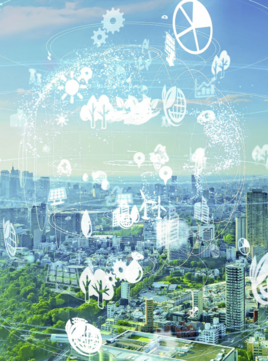Even if we can electrify the main line between these end points, there will be a need to have a secondary on-board power source, shunting arrangement or similar to move trains. These end points may be only a tiny fraction of the total journey, but the need for a secondary power source may dictate major design considerations for locomotives and powered passenger vehicles.
We’ve focused our discussion very heavily on traction options. This may look a little off, given that a recent report on the GB railway’s carbon footprint infers that around 55% is derived from embodied carbon. This will be tied up in the rail lines, the power supply infrastructure, signals, communications, stations, depots, train manufacture, road vehicles and so on.
However, a great deal of the variable carbon element of future infrastructure is likely to depend on traction options, so for the purposes of setting our possible 2050 visions in this paper (there is more than one!), this is a reasonable approach to adopt.
Research and collaboration
We have a very active research programme across the rail industry. As Network Rail is the owner and operator of most of the fixed assets that make up the railway, it clearly has a key role to play. However, the Decarbonisation Taskforce also includes representation from passenger and freight train operators, rolling stock companies, manufacturers, contractors, policy makers, and standards setters.
Decarbonisation demands that we work as an industry. Individual organisations must recognise that they are contributing, on a competitive, collaborative and co-operative basis, to realising industry ambitions, commitments and targets.
This demands the development of expertise, skillsets and competencies that have either not been used to any great extent on the railway or which have to be adapted to support the decarbonisation agenda.
Industry-level decarbonisation research since the publication of the Taskforce report has been focused on establishing baselines.
We have developed a more accurate industry carbon footprint, with a better understanding of where carbon impacts lie and who controls or can influence them.
We are developing guidance and advice on appropriate targets and decarbonisation pathways, which will influence the way that rail entities are challenged to contribute to industry decarbonisation efforts.
We are also exploring what incentives, including options from outside the rail industry, might be used to encourage decarbonisation in a coherent and cost-effective manner.
Other research has identified the steps needed to establish routes into service for battery and hydrogen trains, as well as the likely infrastructure requirements and costing models for hydrogen and battery fuelling/charging facilities based on where these trains are most likely to be deployed.
In future research work across the industry, we are likely to be seeking ways to integrate some of our prior work and known challenges to better understand aspects such as the distributed power supplies likely to be required from an increase in renewable energy generation, upskilling key personnel in carbon management, competencies and standards, carbon, route and network modelling. We will also need to focus on the practical aspects of freight in particular. Figure 3 (above) illustrates these possible areas of focus.
We will continue to evolve and adapt these areas of research as our understanding improves of the immediate and long-term needs to support industry decarbonisation.
2050
So, what does this all tell us about how a low-carbon railway in 2050 might look?
We have, up to now in this article, sought to root our arguments in a well-referenced narrative based on public policy, industry strategic documents and practical research. This is giving us a good idea of the practical, financial and carbon impacts of likely pathways, but cannot tell us how the railway of 2050 might be used.
Events in 2020 and early 2021 open up intriguing and fundamentally different possibilities. We need to ensure that the work we are doing now on rail decarbonisation is sound and adaptable - to allow both for what we expected pre-pandemic and for what could happen in the light of how society might change, and how we work, live and play as a result of what the pandemic has triggered.
There are two main versions of the future opening up as a result of lessons being offered in how society has responded to the COVID-19 pandemic. Please note that we are creating a vision here, rather than seeking to estimate the financial implications of specific options. However, there is no reason why one option should be any less viable than the other.












